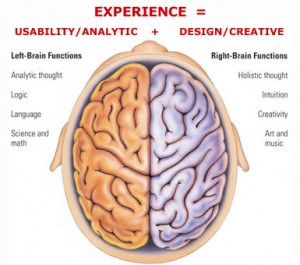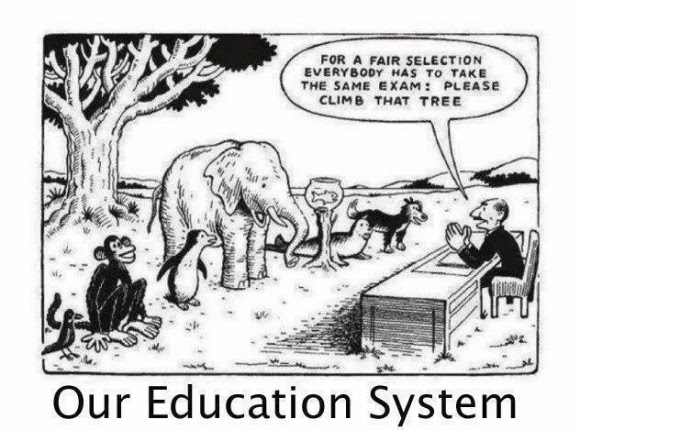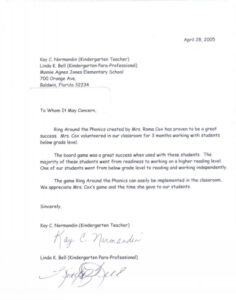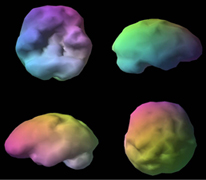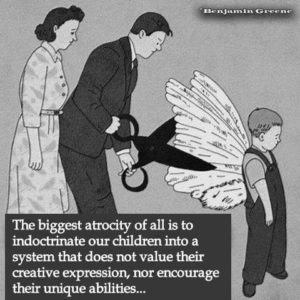Phonics and Reading Blog
Dysfunctional Ideas Create Dysfunctional Lives
“As A Man Thinketh”
As a little girl I use to tell my Mom, “There was a difference between positive thinking, and sticking your head in the sand”. She thought that if she acknowledged a problem, she was saying a giving it more power. So problems weren’t discussed, and festered until they exploded.
Years later I attended a workshop given by a psychologist on why our prison system was not working…Why it was not rehabilitating prisoners. He had been part of a 15 year study on this subject, and said they discovered the following:
- Education does not rehabilitate, because if you educate a criminal, they don’t rob you with a gun anymore. They rob you with a computer.
- Getting them to express their feelings does not work either. If you get an angry criminal to express his feelings, he simply expresses more anger.
What Does Work
The psychologist went on to explain that we all have false ideas. Criminals simply have more of them. It was discovered that by changing their false (dysfunctional ideas) to functional ones, was the solution to rehabilitation. For example: Many criminals would say to him, “Everyone is doing it”. His reply was, “Depends on who you hang around. My friends aren’t doing those things.” The other psychologists were totally enthralled in what he was saying, until he held up the book, As a Man Thinketh: 21st Century Edition (The Wisdom of James Allen) “This book is exactly what I have been talking about”, said the speaker.
True Story
As a youth group leader, a 16 year old girl came to me in tears. She was pregnant, and said, “I don’t understand why God is punishing me. My motives were good. I love the boy.” I said to her, “what happens if I stick my finger in the electric socket?” She replied, “You get shocked.” “Yes”, I said, “and what happens if an innocent baby sticks their finger in an electric socket?” She replied, “It gets shocked.” I went on to explain that it was not God punishing me, the baby or her. It is simply the Law Of Cause And Effect.
Because the sixteen year old falsely believed that her good motives would protect her, she was vulnerable, and open to all kinds of tragedies. Because my Mom falsely believed that she could not acknowledge a problem, she was doomed to suffer the consequences.
Micro Aggression
Martin Luther King taught blacks to be proud (positive thinking). Micro Aggression teaches them they are victims . When you teach someone they are a victim, they become depressed and suicidal, or angry and aggressive. The latter is easily manipulated into becoming a violent mob.
Janice Harper PhD, in her book “Mobbed”, put it as follows: Note: she said it begins by labeling someone, and then identifying them as a group rather than as an individual.
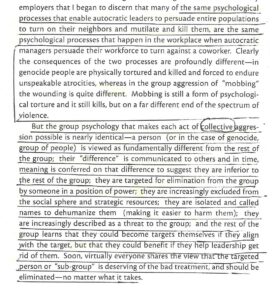
The documentary, “The Mighty Atom”, is a perfect example of positive thinking. “The Mighty Atom tells the incredible true story of Joseph Greenstein, who at 5’4″ became the world’s strongest man. After nearly dying from tuberculosis as a child in Poland, Greenstein unlocked his mind to achieve impossible feats of strength. Stopping an airplane from taking off with his hair, bending cold rolled steel with his hands, biting through nails – An amazing tale of human potential, The Mighty Atom will have audiences cheering.”
In Conclusion: It is our false (dysfunctional) negative ideas that lead us into trouble. Refusing to talk about something negative that is happening is dysfunctional (a negative idea). It carries negative consequences.
Understanding Different Learning Styles impowers parents and Educators
Learning styles are sometimes described using different words: spatial/visual learners who learn by seeing. Some are tactile/kinetic learners who learn by doing and/or touching. Others are auditory learners who learn by listening and talking. The rest may be logical learners who learn by thinking. However Plato broke these different learning styles into much more useful detail, and researchers are rediscovering his words of wisdom still important today. Understanding the different learning styles/ personality types is important because it improves one’s abilities as a parent, teacher, and spouse.
The Analytical Learning Style
In the video above, you will learn about the NT personality (Rational/ Analytical) learning style. They make up only 6 to 12 percent of the average population. Many of the ways they learn best are as follows:
· Because Nts are such a small percentage of the population, they are unlikely to have role models in their lives to help them develop their own unique talents. They are often left up to their own experimentation and exploration for that need. Thus the Unschooling Method of instruction works well for these children.
· Sp adults (see second video) are wise to help the rational child by providing them tactical roles, because little Nts are usually eager to add concrete techniques to their skills. Self esteem is developed by recognizing and praising their inventiveness and cleverness. They are not usually impressed with gold stars on their hands or papers…it makes no sense to them.
· These children love board games like Monopoly , and learning games like Ring Around The Phonics. Note: unlike most children, they will quickly get tired of doing the same activity cards in Ring Around The Phonics. When that happens, I start letting them write their own activity cards, helping them if they have not yet learned to write. It is an excellent way to start teaching them writing skills.
·They are more likely to practice reading if it is a subject that interests them. For example, one of my students likes Star Wars and science books. So I will start out reading to him, pointing to the words as I read, pausing periodically for him to pick up where I leave off (especially when I get to the big words). Because he is interested in the subject matter, he continues the reading (out loud) without any hesitation or instruction from me.
· Once the NT knows their phonic sounds, I use Ring Around The Phonics to teach them root words, prefixes, suffixes and word families which helps them decode the larger words. They also like a challenge, so I will sometimes say, “I am going to try to trick you. lets see if you can read this big word.” Usually just stating something that way motivates them, and they will usually figure it out. However, if they can’t figure it out, they can become quite upset with themselves. That can be a time to teach them it is OK not to be perfect.
· Nts can become quite stubborn if others try to manipulate them. However they can benefit greatly by parents and teachers who help them understand why social niceties are important. It is also important to explain to them why you are having them do something they don’t want to do. They are more likely to cooperate if there is a reason they perceive as logical.
· Most of all parents do well to read to their rational child. They are fascinated by stories.
· They look critically at any plan of action, particularly if based on tradition or custom. Rational children need help in understanding that these things are important to others, and a smooth operation to society. When I say understand, I mean the logic behind such things…not just because “I say so”.
· This is funny but true: The ST child likes to accomplish something while learning, and the NT child likes to be taught how to do things just to satisfy his desire to know. So both personalities will learn while building something like a room addition. However, a word of caution; the NT will often stray from the standard way of doing the job just to find out “what if”. It can be quite an adventure.
Nts are very good at analytical thinking, and have trouble understanding that their sarcastic remarks toward others, who are not so analytical, are hurtful. They benefit greatly by understanding the different personality types, and it helps them to develop some of the social niceties.
Note: (It is important not to put inflexible labels on ourselves and others, because, even though we tend to be more of one personality than another, we are never one hundred percent in any one category, and different situations can bring out different traits.)
The Sp (Artisan, hands on, kinesthetic) learning Style
In this video, you will learn about the Sp (Artisan) learning style. Even though they are 38% of the of the average classroom, they are the most misunderstood. As a result, studies show, they are the most likely to drop out of school early. Some of the ways they learn best are as follows:
· They like to entertain and to be entertained
· Prefer visual over verbal learning
· The more game like it is, the better
· Team play and competition works well with these children
· It is more important to praise their performance, than to praise their product
· They like short activities in which they can move around
· For children that are learning to read, or having trouble learning to read we have found nothing better than Ring Around the Phonics. Hands on learners love it.
· The Artisan often sees other personality types as “stupid”. However if they are helped to learn about, and appreciate the unique gifts of others, they can become Great leaders.
· This is funny but true: The Artisan child likes to accomplish something while learning, and the NT child likes to be taught how to do things just to satisfy his desire to know. So both personalities will learn while building something like a room addition. However, a word of caution; the NT will often stray from the standard way of doing the job just to find out “what if”. It can be quite an adventure.
(It is important not to put inflexible labels on ourselves and others, because, even though we tend to be more of one personality than another, we are never one hundred percent in any one category, and different situations can bring out different traits.)
The Nf (intuitive-feeling, idealist) Learning Style
In this video, you will learn about the NF personality (Intuitive Feeling) learning style. They are only 12 percent of the average population, but have had a profound effect on society. In fact, Gandhi was an NF. Some of the ways they learn best are as follows:
· A personal note written about their work can be a powerful motivator to these children as long as it is positive. A negative approach can provoke an NF into rebellion or inaction.
· Like the SP, the NF learns best from discussion and role playing methods .
· Their vocabulary often exceeds their ability to put things on paper. So, putting their thoughts on a recording first, often helps their creativity.
· Unlike the SP, they prefer team work over competition. They are highly sensitive, and feel the pain of others. As a result, they will often let others win so as not to hurt them. When I play learning games with these children, I am quick to announce that everyone is a winner because they completed the task.
· “The NF child can be particularly responsive to teachers who are accepting and nourishing, who verbalize recognition of feelings, who individualize their instruction, who use lots of small group interaction, who genuinely respond to and accept the ideas and opinions of class members, and who avoid sarcasm and ridicule as a means of control.” (page 128 Please Understand Me: Character and Temperament Types
· The Idealist learns best through discussion, and role playing, but will adjust to various methods of teaching (Eclectic) as long as it is serving the people involved, and not perceived as cruel or exclusive.
· These children seem to have high moral expectations of themselves, and can be perfectionists in that regard. Unlike the SP, the NF can feel guilt when acting devilish, and often have to learn how to stand up for themselves in a positive manner.
· While the SP wants to know how his toys work, the NF child is more likely to weave imaginary stories around his/ her toys. They can become quite attached to them, feeling a great loss when one is lost or left behind.
· The Introverted NF can become very isolated, and needs help developing social skills in order to develop their full potential. That is not to say they need to become more extroverted, but that they need to develop some social skills in dealing with others.
(It is important not to put inflexible labels on ourselves and others, because, even though we tend to be more of one personality than another, we are never one hundred percent in any one category, and different situations can bring out different traits.)
Sj (Guardian) Learning Style
In this video, you will learn about the SJ (Guardian) learning style. They make up 40 to 45 percent of the average population. Some of the ways they learn best are as follows:
· They like sticky stars and the like placed on their papers and hands.
· Unlike the SP (artisan), the guardian child will sit quietly waiting for instructions.
· Little Sjs usually respond well to specific assignments and responsibilities like feeding the pets, or setting the table.
· Their source of pride is the approval they receive from figures of authority when they do a job well. Doing their best loses its appeal if approval is not forthcoming. If they are less than helpful, their self respect can suffer as they develop feelings of guilt.
· They do well with workbooks, and the Conventional Method of instruction.
My father was an NT (rational), and my mother an SJ. Mother was quite intelligent in her own way. She was far more successful at running business enterprises, and tending to details. But because she was not good in analytical conversations, my father did not appreciate her unique intelligence. SJs are a good balance for the NT only if the differences are understood and appreciated. Otherwise they become a source of irritation and division.
Note: (It is important not to put inflexible labels on ourselves and others, because, even though we tend to be more of one personality than another, we are never one hundred percent in any one category, and different situations can bring out different traits.)
Resource
The book below not only teach more about the personality types, but it also has a test that one can take with family and friends to help us understand each other better. I found this activity fun and informative. I highly recommend the book because it improves relationships.
https://keirsey.com/temperament/guardian-overview/
Please Understand Me II, by David Keirsey
ADD / ADHD: Here you will learn how to help these children.
It is often thought that these children are unable to concentrate. In reality, the child with ADD / ADHD is apt to lock in with an exceptional degree of focus when he is genuinely interested. (Resource 1, Page 50). At an early age Einstein was considered lacking in intelligence, because teachers had trouble getting him to focus. (Resource 1 below, page 56).
- Because of MRI and SPEC brain scans, psychologists are rethinking everything they knew about learning disorders.
- According to Dr. Amen, there are 7 different kinds of ADD . Note that not all of them show brain damage, which indicates that some may be what is often described as different learning styles as far back as Plato. In other words, at least some of those diagnosed with ADD/ ADHD may not have a learning disorder at all.
- Like so many learning disorders, there are gifts of genius attached. Einstein’s dis-tractability, which is common among children with ADD / ADHD, is what enabled him to develop his Theory of Relativity. It is important that parents and educators understand their children’s strengths, and not just their weaknesses. Spend more time on their interests, rather than their weaknesses. (Resource 1) page 63). What really disables a person is their belief that they are disabled (Resource 1, page 64). There is good suffering, which is working at something. Bad suffering is humiliation, depression and isolation (Resource 1, page 65)
The Genius That Goes With ADD / ADHD
- These children showed an enhanced ability to overcome “constraining influences”. (Resource 1, page 54).
- 40% of children with ADD / ADHD also have dyslexia. When they are reading something that disinterests them, their mind wonders uncontrollably (Resource 1, Page 57). When they are reading something that interests them, their mind can be laser-beam intense. (Resource 1, Page 58). This also describes the learning styles analytical thinker, and hands on learners.
- Someone who is impulsive by nature can “make a lot of mistakes” in business. So hook up with someone who is by nature methodical and looks at all the possibilities (Resource 1, page 63). Walt Disney was highly creative in his field of interest. But he was unable to make a success of his abilities, until he hired his bother to help him.
- Drugs do not teach the behaviors that will help those with ADD / ADHD function in the world and workplace as they grow older (Resource 1, page 67).
- When given the least structure, these children are better able to discipline themselves (Resource 1, page 67). They also need to take frequent breaks (Resource 1, page 69). Both of these things are also true with the learning styles of the Hands On Learner, and the Analytical Thinker.
- What is obvious to children with ADD / ADHD and dyslexia, others don’t see at all. They have an uncanny ability to connect seemingly unrelated ideas. (Resource 1, pages 70-71). It is a mistake to think that we need to make brain differences go away (Resource 1, page 77). Einstein, who so hated rote learning, once said, “Imagination is more important than knowledge.” (Resource 1, Page 78)
How To Help These Children Succeed
- Finding a field or area of interest that captivates the child with with ADD / ADHD is perhaps the single most important way to ensure future success in life (Resource 1, Page 72). When you find areas of talent, then motivation will follow.” (Resource 1, Page 74).
Resources
- The Power of Different: The Link Between Disorder and Genius
- Karen Walker, a professional tutor, recommends Ring Around The Phonics (Whole Brain Teaching) to help children with ADD learn to read..
Helping the Child With a Learning Disorder
 Children are too often labeled with a learning disorder. We hear so many such labels: (1) Dyslexia, (2) ADD, ADHD and other attention disorders, (3) anxiety, (4) Melancholy (depression), (5) Bipolar, (6) Schizophrenia, (7) or Autism Spectrum.
Children are too often labeled with a learning disorder. We hear so many such labels: (1) Dyslexia, (2) ADD, ADHD and other attention disorders, (3) anxiety, (4) Melancholy (depression), (5) Bipolar, (6) Schizophrenia, (7) or Autism Spectrum.
It is painful and destructive to the child. But It is also destructive and painful to the parent and society as well. Insurance companies require these labels in order to issue payment on treatment. But it is by nature very inaccurate and misleading: it is not how those in the medical field treat patients (resource 1, page 15).
Recent discoveries about learning disorders
It is important to note that recent discoveries using brain MRI and SPEC scans are causing those in the field to rethink everything they thought they knew about learning disorders. Science and insurance companies both were wrong. Here is what parents and teachers of these inaccurately labeled children need to understand:
Important things to know about all learning disorders:
We have been wrong: focusing mostly on areas of learning in which children were weakest. We now know it is much more important to focus mostly on a child’s interests.
Instead focus 80% on what interest the children, and 20% on their weakest areas. This is just opposite of what educators have been doing, and can cause more harm than good.
We have learned even more:
- There is no such thing as a normal brain. (resource 1 pg 7)
- Scientists were surprised to learn that the most creative individuals are at higher risk for mental illness than are the less creative.
- We have all seen examples of those with brain differences achieve great success. Scientists were surprised to learn that these people often achieve great success because of their learning disorder, not in spite of. (resource 1, pg 9)
- Einstein could not have made his historic scientific breakthroughs were it not for his day dreamy, distractible mind (ADD). In the words of psychologist Scott Barry Kaufman, ” I don’t think everyone (with a brain difference) has the potential to achieve greatness in every field, but I think everyone has the potential to achieve greatness in some field.” (resource 1, pg 11) If we educators find that spark that ignites their interest, these children find ways to achieve what interests them, even if it takes improving what they are weak in.
- “The irony is that while my patients are focused on getting past the obstacles that exist between them and their larger goals, it is very often, the case that there is great strength to be mind from those obstacles, and brilliance to be observed in how my patients both utilize their struggles, and maneuver around them.” (resource 1,pg 12) In fact children who do not learn to overcome obstacles are less equipped to overcome them as adults.
- “Every single healthy human being lies somewhere on every psychopathology spectrum (e.g. schizophrenia, autism, mood disorders). What’s more, we each show substantial fluctuations on each of these dimensions each day, and across our lifespan”. Mental disorders are not only prevalent, they’re overlapping. There is no such thing as a single, neat diagnosis. (resource 1, pg 8)
Note:
- Plato talked about different personality types /learning styles, and it still holds true today. Different personalities types/ learning styles are often misdiagnosed as having learning disabilities (resource 2).
- Whole Brain Teaching improves the health of the brain for those with learning disabilities. Learn more at our website.
- How To Help Your Child Learn is a real life experience that illustrates this subject.
- Karen is a professional tutor. She uses Ring Around The Phonics to teach children with learning disabilities.
Resources
- The Power of Different: The Link Between Disorder and Genius
, by Gail Saltz, M.D.
- Please Understand Me II
., by David Keirsey
Homeschool For This Teacher
Following is a delightful and funny true life story told by a public school teacher who became a homeschool mom. If you are thinking about homeschooling, or if you want to improve your homeschool abilities, this article is for you.
True Story
“At first I wanted them to sit at a desk and learn like I did. I set up my classroom like a school classroom with a computer station. I began using K12. I wanted a teacher who “really taught” that particular grade to oversee everything. I had never taught elementary school. I set up a desk for each child that faced a big whiteboard at the front of my classroom. We sat in circle time at the beginning of each day and we would discuss the weather, day of the week, and all these other things. It was the most productive time of the day, but I thought it was because the kids were “fresh.” I found later that it’s because they were totally, whole body engaged. (This link is an article on the Florida Homeschool Association. When you homeschool, the whole world becomes your classroom.) They were wiggling and going to the bulletin board to put up the answers. They were lying on the floor and getting tickled when they answered. But it was what I saw in a “real classroom, so that was why I tried it.
I felt that I needed a textbook for each class, K12 provided all these textbooks and workbooks (one for each class) and I intended to use them. I watched the grades slip in spelling and I saw the boys learn the spelling rule and list of words and then forget. Their writing was full of misspelled, former spelling words. I watched my youngest hate phonics “class” to the point where he was beginning to hate reading. And I watched my oldest get frustrated by the rhythm of follow the textbook’s activities then do 2 worksheets of problems in the math program.
Circle Time !
Facing those 3 problems: too much kill and drill/ follow the textbook/ and desk time was MUCH less productive than circle time. We redesigned our room. We are now down to 2 desks and 2 computers (for all 4 of us). We spend most of our time on the couch (in the living room), the floor (2 bean bags and 2 huge pillows), and running around than we do at desks. Plus experiments at the kitchen table, ya know where there’s a SINK nearby, just make much more sense. We can all gather round, everybody can get their hands involved. For the textbook problem I realized I would need to leave K12. So I did. (Well there were a billion other reasons for us to leave, but this is the reason that applies here)
While teaching in a public school, Video was a dirty word!! Now I know that for some learning styles it works very well (and easy to do when homeschooling). In the past few months we’ve watched many science documentaries. We’ve read books and then watched the movie and written or spoke comparisons. I’ve watched their oral vocabulary soar!! Not getting a phonics rule, a chemical reaction, and a trajectory equation? There is most likely a YouTube (a free homeschooling too)l for that! And it probably has a song about it, especially for the LOs.
More Flexability
I’ve also learned that my response time is much faster when teaching fewer kids. So I don’t need to teach them for 6 hours/day (another benefit made possible by homeschooling) . I can respond to their uncertainty or find a better way to explain it much faster. Or I can move to something else, take the evening looking for a better way and hit it fresh in the morning. I can be much more flexible than I could ever be in the classroom. We can go outside (without asking permission or filling out a form!!) (the blessings that come with homeschooling), I don’t have to tell anybody if I plan to blow something up!! I just do it. Then some really cool things happened:
I learned to stop giving grades. When they get above 87%, we move on. They don’t need a grade and I don’t need them to take a test in order for me to figure out they have or don’t have something.
The Old One Room School House Method
I learned that it is okay to have my kids teach or help each other. I tried that my first few years teaching in the PSs, and I would end up having to teach it again because the group didn’t understand it well enough to teach it in the first place. But now, my oldest has had the lesson before, so it is a great review for him to teach it to his brothers. Then I can build on it and go deeper with him.
So then I needed to find a solution to those textbooks. I found the solution in my objectives!! I was looking at them the wrong way!! When I was using k12 the objectives came packaged to my door. When I went out on my own, I bought the “2nd grade science book” and the “second grade math book” and “spelling grade 3.” I created some general objectives and went on with the lessons. I followed the book.
The World Is My School Room
I learned that my general objectives were great, but if I made my specific objectives even more specific, I was able to use them as discussion questions and move on without a test. Then I noticed that my objectives were a great jumping off point for finding books and materials. In the PS, the materials were usually the jumping off point for making my objectives. Looking at it from the flipped perspective opens up learning to a world experience. I could ask the boys to come up with objectives themselves! What do YOU want to be able to do? And boy oh boy did they provide! Using their objectives and some of mine along with a scope and sequencing guide: off we went. I would find multiple textbooks for each subject. And it was OK if we didn’t follow in order and we didn’t finish the book and we used it just as a reference for its great experiments. We might use another part next year! I could tag things that we liked, didn’t like, whatever. The world opened up to us. I began to see that the trip to the farmer’s market was a learning opportunity. We stopped “book learning” altogether for the big holiday breaks and learned through our baking, card making, gift giving. I took them to the bank and opened an account. They get a statement and we talk about it every month. Just every single day. Learning.
Lead And Follow
I’m sure my journey isn’t “done” and probably never will be. BUT now I stopped thinking like I was taught in college about how to teach the material. I’ve learned to both lead and follow. It’s brought me closer to the boys. We have many more good days now, and many fewer bad days (oh they are still there! And still make me want to rip my hair out). One of the few things I’ve kept is the diagnostic tests. We still take an online diagnostic test. Their “scores” always put them about 3-4 grade levels ahead, so I “know” that they are doing well. But mostly it’s so that the naysayers in the family just shush and let us go on……By “bluerooffarm”, on Cafemom.”
Thanks to this teacher, turned homeschool mom, for allowing me to print her personal story. She explains common mistakes that many make when they start homeschooling, and how she improved her ability to homeschool. Her story can save you and your children a lot of heart ache. Homeschool is so much more fun when you use full body engagement.
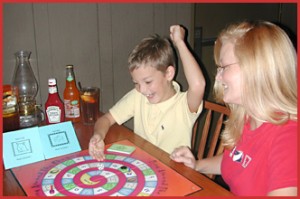 As a home school workshop leader, I am often asked questions about how to get started home schooling my child. This page is especially for newbies, but the experienced home educators can also benefit. Most parents care very deeply about their children (more so than the Department of Education). Studies show that home educated children outperform their public schooled counterparts even if the parent holds no degrees.
As a home school workshop leader, I am often asked questions about how to get started home schooling my child. This page is especially for newbies, but the experienced home educators can also benefit. Most parents care very deeply about their children (more so than the Department of Education). Studies show that home educated children outperform their public schooled counterparts even if the parent holds no degrees.
So, I tell parents that home school is not the classroom, and that when you home school, the whole world is your classroom. That is important, because with a little information, one does not have to spend tons of money to do a good job. Put your money where it will benefit the child the most. Following is some information that will help you
1. The very first step is to know your state laws. Your State Home School Associations are usually most helpful in this matter.
2. Knowing your child’s learning style will help you save money on curriculum that does not work with your child. Workbooks work just fine with some children (45% of the population), but do more harm than good for the rest of the children.
3. Physically involving the child in the learning process According to Dr. Amen, a physician, and double board certified psychiatrist, whole brain teaching improves the health of the brain. It also helps you teach to the different learning styles, and children with ADD/ ADHD, Dyslexia, asperger’s syndrome and anxiety disorders. As a result children learn faster, retain more, and retain their love for learning for a life time. The following story is a funny, informative and inspirational story a certified teacher experienced in her journey to becoming a home educator. It reveals a lot about what works, and what doesn’t when teaching children. My journey from Public School Teacher to Homeschooling Mom
4. There are some good free computer games on line that physically involve the children in the learning process. But they are not good for teaching phonics, because they teach some of the sounds incorrectly making it hard for some children to blend the sounds to form words (it makes phonics pointless, and many children revert to sight word recognition). It is important that you teach the child the sounds (rather than a computer), so you know they are taught the basics correctly…We have provided you free videos to hear phonic sounds to help you do just that. (for parents….not the child)
5. How to Help Your Child Learn
6. Ring Around the Phonics (game for reading, phonics and Language Arts), and Math U See’s the beginning lessons, both teach to the various senses thus improving the health of the brain. Ring Around the Phonics has also shown to teach to different learning styles, and learning disabilities as described above. What is so wonderful about home schooling is that you adjust the lesson plans to the child rather than trying to force the child into a one size fits all lesson plan.
Sometimes parents feel they are not qualified to teach their child to read. I always ask them if they can read. If you can read, you can teach your child to read. It is very easy with a little information, and the right tools.
- Many home educators look for ways to earn extra income from home. Ring Around the Phonics and Math U See are very effective tutoring tools that can earn you extra income.8. If you have other questions, please feel free to contact Roma.
- How To Homeschool Your Child.
- Gayl Saltz, M.D. provides valuable information for parents who have children diagnosed with learning disabilities.
- Labels have consequences (CRT, Men are Toxic, exedra)
Learning Phonics RulesNote: The children need to be proficient and comfortable with phonic sounds and reading before teaching the phonics rules. Otherwise it is like telling a child they must know how to assemble and disassemble a bike before riding…it is too overwhelming. Phonic RulesConsonant letters: b, c, d, f, g, h, j, k, l, m, n, p, q, r, s, t, v, w, x, z and often y. Each letter usually stands for one sound. The letters c and g have two sounds each called hard or soft. Example: When either c or g is followed by e, i, or y, the sound is usually soft – cent gem. Other wise the sound is hard – can go. Consonant digraph: two consonant letters that together stand for a single sound different from either consonant sound alone: chop ship phone think Silent Letter if two letters together represent the sound of only one of them, the other is “silent”: knot, write, ghost, scent. Vowel Letters: a, e, i, o, u, and sometimes y. Each letter stands for more than one sound. One is called a short sound, and the other is called a long sound (hear phonic sounds for free) When a short word (or a syllable) ends in a consonant the vowel sound is often short: Hat, hen, hit, hot, hut hymn. When a short word ends with an e, the first vowel is long and the e is silent: cape, Pete, bite, note, tube dye. Vowel digraph: two vowel letters that together stand for a single sound: (hear phonics blends) When a word has two vowel letters together, the first vowel is usually long and the second vowel is usually silent: paid, pay, meal, meet, die, boat, toe The letters ea can also stand for short e as in bread When a word or syllable has only one vowel and it is at the end, the vowel is usually long: she, go, sky, pi-lot, so-lo Vowel diphthong: a vowel blend made up of two adjoining vowel sounds: When a word has the following vowel combinations, these sounds (diphthongs) are the most common: ai cain au cause ow cow, crow ou loud, soup ew knew ei eight Vowel followed by r: When a vowel is followed by r, the vowel is different from either the long or the short vowel These have the same sound: Plural: more than one – cats, glasses Inflectional endings: s, es, ed and ing are added to base words to indicate number or tense. play: plays, played, playing When you add ed or ing to a base word that ends in e, drop the e first: wave: waved, waving Compound word: two or more words joined together to make a new word. sidewalk, outside raindrop Contraction: two words written as one. An apostrophe replaces the missing letter(s) can’t for cannot I’ll for I will More Phonics Rules:Syllable: a word or part of a word pronounced as a unit. Each syllable contains one vowel sound. to-ma-to ref-er-ee Synonyms: words that have the same, or almost the same meaning. boat, ship jar, bottle over, above Antonyms: words whose meanings are opposite, or almost opposite. good, bad up, down thin, thick Homonyms: words that sound alike but have different spellings and meanings. here, hear hare, hair to, too, two Base word or root word: a word without prefixes, suffixes or inflectional endings. Note: Learning root words can be even more helpful than learning the phonics rules. It can help with reading and spelling. Many words are made up of a root (or base word) and a prefix. Some words also have a suffix. For example, the root word port means to carry or to bear. Attach the prefix ex, meaning out or out of, and you have the word export, to carry out. Attach the prefix im, meaning in or into and you have import, to carry in. Attach the prefix trans, meaning across, and you have transport, meaning to carry across. Now let’s attach the suffix able, meaning able to be, and you have importable, exportable, and transportable. Thus an excellent way to teach spelling, especially to the dyslexic, is to teach root words first, and then add prefixes and suffixes. Ring Around The Phonics is used to teach spelling. prefix: a word part that can be added to the beginning of a word to form a new word with a different meaning. suffix: a word part that can be added to the end of a word to form a new word with a different meaning. tasteless sharpen joyful Schwa: the vowel sound heard in unstressed syllables, sometimes called a “mummy vowel”. |
If Your Child Has Trouble Reading But:
Is your child having trouble reading (struggle as a slow reader, difficulty blending the phonic sounds to form words, or is a poor speller? There can be many reasons that can cause children to have trouble with reading and spelling, such as hearing problems, and vision problems. However, as a professional tutor, I have found the most common cause is as follows:
Most Common in Poor Readers
Computer games teach several of the following phonic sounds incorrectly: B, C, D, G, H, J, K, (occasionally M), P, T, W. Computers add an u sound at the end of many of these letters to make them more audible to the listener. But this causes problems for some children. We do not say Hu-a-Pu-Y for happy, nor do we say Du-a-du-y for daddy. Think about how difficult it is to hear happy when pronouncing it as hu-a-pu-y. Most of the struggling readers I have helped were pronouncing one or more of these sounds incorrectly.
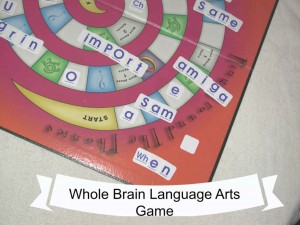 For one child, it was simply the letter w. Because she was having trouble sounding out words with w in them, she concluded that something was wrong with her. It became a self-fulfilling prophesy. She freaked out every time she was asked to read from her early reader books… proclaiming, ” I can’t”. By using the game “Ring Around The Phonics“, I re-taught her the correct way to say the sound of the W, and also used the board to help her blend the sounds. Because games are [whole brain teaching]), stress was reduced, and she quickly learned.
For one child, it was simply the letter w. Because she was having trouble sounding out words with w in them, she concluded that something was wrong with her. It became a self-fulfilling prophesy. She freaked out every time she was asked to read from her early reader books… proclaiming, ” I can’t”. By using the game “Ring Around The Phonics“, I re-taught her the correct way to say the sound of the W, and also used the board to help her blend the sounds. Because games are [whole brain teaching]), stress was reduced, and she quickly learned.
However at first, the books still stopped her in her stacks. She still had trouble reading from books even though she could read any word placed on the board game. So once I was sure she knew the phonic sounds, and could read words placed on the board, we stopped playing the game and did as follows:
When she came to a word in the book that stressed her, I simply placed that same word on the board using the static cling letter cards provided. She could read it on the board, but not the book. So I kept pointing to the word on the board, and then to the same word in the book. I repeated this process until she finally realized she could read! She went from failing to top reader, and the teacher even said it improved her spelling. Following is a letter from her teacher:
So don’t underestimate the problems that phonic sounds learned incorrectly can cause. It does not effect all children. So if they have learned the phonic sounds incorrectly, and are not having trouble reading, don’t fix it. But for many children, it is important to get the basics right. Therefore we recommend you, the educator (not an electronic device), teach the phonic sounds so that you are sure they are learning the basics correctly. Click Here To Hear The Phonic Sounds (video format for adults). And remember that we are always here for you. Feel free to contact us.
 Phonics Reading Games Can Improve Brain Health, And Ability To Learn?
Phonics Reading Games Can Improve Brain Health, And Ability To Learn?
Studies show that whole brain teaching (example: Ring Around The Phonics) improves brain health, and the ability to learn. Yet, many schools are failing children, because They are not using the Scientific research. Many educators now understand that each person prefers different learning (and teaching) styles. However learning styles are not written in stone. One can actually strengthen the less dominant learning (and teaching) styles. Why is this important?
According to the latest brain research: Learning is as natural as breathing. It is possible to either weaken or strengthen a child’s natural desire and ability to learn in different life situations.
Researchers, using brain-imaging technologies, have been able to find the key areas of the brain responsible for each learning style. They are also able to see the actual brain improvements.
Different learning styles located in the brain:
1. Visual/ spatial learners prefer using pictures, images, and spatial understanding. This style develops the occipital lobes at the back of the brain. Both the occipital and parietal lobes manage spatial orientation.
2. Aural learners (auditory – musical) prefer using sound and music. They have developed the temporal portion of the brain. The right temporal lobe is especially important for music.
3. Verbal learners prefer using words, both in speech and writing. This learning style is managed within the temporal and frontal lobes. Two areas called the Broca’s and Wernicke’s areas (in the left hemisphere of the temporal and frontal lobes.) are especially important.
4. Physical (Kinesthetic) learners prefer using their body (hands and the sense of touch). These children have a well-developed cerebellum and motor cortex which is at the back of the frontal lobe.
5. Logical learners prefer logic reasoning and systems. Studies show that these children have well-developed parietal lobes, especially on the left side of the brain.
6. Social learners prefer learning in groups, or with other people. These children have developed the temporal lobes.
7. Solitary learners prefer working alone, and using self-study. The frontal and parietal lobes, and the limbic system are very active with this style.
Important Studies On The Frontal Lobe
The frontal lobes play a very important role in regulating our emotional sates and judgments. It is the critical thinker…. the part of the brain that thinks about the consequences of an action. It is not fully developed until the mid 20s. Children who are hindered in developing this part of the brain, can exhibit serious emotional problems.
It was once believed that if you encouraged a person to express their angry emotions, it would “get it out / process it”. However a 15 year study of prisoners commissioned by the government, revealed something very different. If you got an angry prisoner to express his anger, he became angrier. It also revealed that if you educated him, you got an educated criminal….he did not rip you off with a gun anymore, he ripped you of with a computer.
So what did work in that 15 year study?
Developing the frontal lobe worked. How? It was discovered that even though we all have some degree of false ideas, criminals have more. For example: criminals (like many children) responded, “Well everyone is doing it”. The response from the psychologist was, “Well it depends on who your friends are. Mine aren’t doing those things.” In other words, to develop the critical thinking (frontal lobe). It means replacing a dysfunctional idea, with a functional one (“As A Man Thinketh”). A healthy frontal lobe helps one to override the execution of automatic behaviors. It overrides potentially destructive illegal or immoral behaviors that are sparked by emotional biases
Use it or lose it.
While it is highly important to provide plenty of opportunity to reach each child through their preferred learning style, it is equally important to exercise the whole brain…use it or lose it. Research shows that by involving more of the brain during the learning process, children remember and retain more of what they learn. According to Dr. Amen, whole brain teaching even improves the health of the brain (use it, or lose it). Help your child with games like Ring Around The Phonics.
Order the game Here using PayPal (be sure to check out the savings on our Value Pack). You can also order the game on Amazon here.
Or read more:
SPECT Scan Of A Healthy Brain
(Source http://www.amenclinics.com/ )
(To see a picture of the brain showing the different parts, and to learn more about their functions: http://www.webmd.com/brain/picture-of-the-brain )
Public Schools:
The public school system uses mainly the “conventional method” of teaching: workbooks, lectures, flash cards, reading and multiple choice — sit down a desk type work. Not only does this not improve the health of the different parts of the brain, but it is a disaster for some children. For example: Very bright “hands on learners” (38 % of the population) are often labeled as slow learners, problem children, ADHD, or called dumb by their class mates. why? Because the conventional method does not work for them. As a result, they often become convinced that “something is wrong with them“. However give these children a hands experience (like our phonics reading game), and they shine.
Applications For Whole Brain Health And Development
So it has become evident that it is important not to just develop parts of the brain, but to develop the whole brain. Studies show that with whole brain teaching (involving as many of the senses as possible), children learn faster, and retain more. Dropout rates decrease by 90%, and the health of the brain is improved.
1. Frontal Lobe Learning ignored in today’s classroom
Emotions simply exist; we don’t learn them in the same way we learn telephone numbers, and we can’t easily change them. But we should not ignore them. Children can learn how and when to use rational processes to override their negative emotions, or to hold them in check by developing the frontal lobe area of the brain…learning that there are consequences to one’s actions. This part of the brain is almost totally ignored in today’s classroom setting.
2. Too much stress can cause learning disabilities
Learning is enhanced by challenge and inhibited by threat.
Emotionally stressful environments (for the educator and the student) are counterproductive because they can reduce children’s ability to learn. http://www.mayoclinic.org/stress/art-20046037
3. Understanding each individual – One size does not fit all
individual – One size does not fit all
Learning is influenced by the natural development of the body and brain. According to brain research for example, there can be a five-year difference in maturation between any two “average” children. Gauging achievement on the basis of chronological age is therefore inappropriate, and counterproductive.
4. Make It Experiential (Hands On)
The brain understands and remembers best when facts and skills are embedded in natural spatial memory… we remember what we experience. This principle can be applied to every subject through games (like Ring Around The Phonics), activities and real life experiences: involving as many of the senses in the learning process as possible. This is particularly important for the “hands on learner“. Educators should not exclude lectures and sit down at a desk type work; but they should make them part of a larger experience.
5. Find The Individual Passions
Each brain is unique. Teaching should be multifaceted in order to attract different interests, and to develop the whole brain. Helping children find their passion is a major part of their future success.
6. The objective of brain based teaching is to move from memorizing information to experiencing information.
7. Empower educators to do whatever is in the best interest of each individual child. One size does not fit all.
Resources:
- Even though these things have been recently learned by way of cognitive science’s brain scans, the method has been around over 30 years. It is known as “Total Physical Response“. Studies show that, with this method, children learn faster, retain more, drop rate decreases by 90%, and the health of the brain is improved.
Source: https://ringaroundthephonics.com/articles.htm#A11 - For a real life example: “My Journey From Public School Teacher To Homeschooling Mom“: https://ringaroundthephonics.com/2017/04/11/homeschool-public-school-teacher/
- How to Help your child learn is also a true story that provides you and your child help.
- Gail Saltz, M.D. provides valuable information for parents who have children diagnosed with learning disabilities.
Ring Around The Phonics is a reading game that physically involves the children as they learn. To you, the educator, the child is learning. But to the child, they are having fun. They literally beg to play


